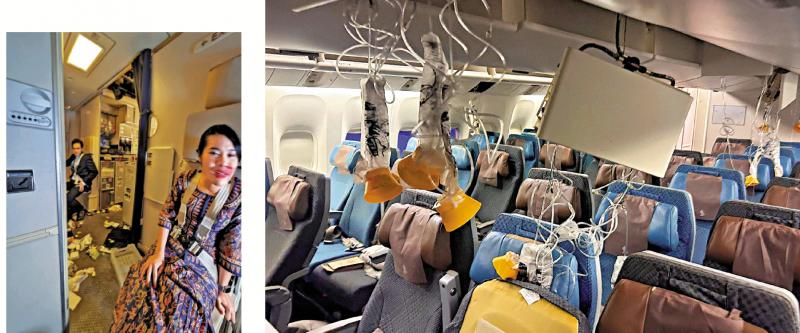
Left: Photos circulated on the Internet show that a stewardess was injured and bleeding on her face\ Network pictures; Right: Oxygen masks and other objects fall from above the seats in a Singapore Airlines passenger plane encountering turbulence\ Reuters
A Boeing 777-300ER passenger plane of Singapore Airlines with 229 people on board was originally scheduled to fly from London, England to Singapore, but it suffered severe turbulence, resulting in one death and dozens of injuries. The airliner made an emergency landing at Suvarnabhumi Airport in Bangkok, Thailand, on the afternoon of the 21st local time. The airport manager confirmed that the deceased was a 73 year old British male passenger who suffered from heart disease. Seven of the dozens of injured suffered serious head injuries. It is reported that the plane dropped 6000 feet (more than 1800 meters) in three minutes, many passengers without seat belts hit the ceiling, and the cabin screamed everywhere.
Gidi Kasong, general manager of Suvarnabhumi Airport, said at the press conference that a 73 year old British man died in the accident, possibly due to a heart attack. British media said that the man was a musical director Kichin.
Several media reported that 30 people were injured on board, including 7 with serious head injuries. The Guardian quoted a police officer from the Srinakalin Hospital in Bangkok as saying that at least 70 people were taken to the hospital because of injuries.
No Chinese passengers on board
Singapore Airlines said that one person was confirmed to have died, 18 of the wounded had been hospitalized, and another 12 were in hospital for treatment. The company is cooperating with the Thai authorities to provide all necessary assistance, express its deepest condolences to the bereaved families, and apologize for the traumatic experience of the passengers and crew. According to the statement issued by SIA, there are no Chinese passengers on board. The Hong Kong Immigration Department also said that it has not received any help from Hong Kong people so far.
Flight tracking data obtained by FlightRadar24 shows that the flight suddenly dropped from 37000 feet to 31000 feet within 3 minutes after taking off from London about 11 hours ago. Passenger Davis told the BBC that the plane "suddenly fell down" at the time of the incident, and the turbulence led to articles scurrying in the cabin. "Coffee spilled all over me, and there was a terrible scream on the plane".
Azmir, a 28 year old passenger on board, said that the plane suddenly tilted upward, then shook, and then plummeted, causing passengers sitting in seats but not wearing seat belts to be suddenly thrown to the ceiling of the cabin. "Some people hit their heads into the luggage compartment above, and some panels were dented."
Photos in the cabin circulated on social media show that passengers with tense facial expressions cling tightly to their seats, oxygen masks fall from overhead, personal belongings, meals and garbage are scattered on the aisle, and stewardesses have blood masks. After the forced landing of the plane, Gidi Kasong described the situation in the cabin as "chaos". Many passengers could not get off the plane on their own and needed assistance.
This is the latest accident of Boeing aircraft this year. Singapore Airlines has had no major accidents in recent years. In 2000, the company's flight crashed in Taipei Taoyuan International Airport due to typhoon, resulting in 83 deaths.
Climate warming intensifies turbulence
According to the Federal Aviation Administration (FAA), turbulence (also known as turbulence) is the main cause of injuries to flight attendants and passengers in non fatal accidents. According to the National Transportation Safety Board (NTSB), turbulence induced flight accidents are one of the most common aviation accidents.
Williams, professor of atmospheric science at the University of Reading, UK, pointed out that turbulence can be divided into mild turbulence, moderate turbulence and severe turbulence. When the plane encounters mild turbulence, flight attendants can continue to deliver meals and passengers can also walk in the cabin, but it will be slightly difficult. Moderate turbulence will lead to the falling off of objects that are not fixed properly. Severe turbulence is stronger than gravity. If passengers do not wear seat belts, they will be thrown around, which may cause serious injuries such as fractures.
Every year, about 65000 aircraft in the United States experience moderate turbulence, and about 5500 aircraft experience severe turbulence. However, with global warming, the number of severe turbulence may double or triple in the coming decades. One kind of turbulence is called "clear sky turbulence", which comes without warning, greatly increasing the probability of accidents. Williams predicts that the global clear air turbulence will increase significantly from 2050 to 2030, especially in the busiest routes.
Industry calls for stricter flight rules
CNN said that wearing a seat belt at all times is the best way to minimize the possibility of injury due to turbulence. In all turbulence related flight accidents, flight attendants account for about 80%. Nelson, president of the American Flight Attendant Association, said that the stewardess "was thrown on the ceiling and then fell down, resulting in broken limbs".
In order to prevent turbulence from causing greater damage, the industry calls for stricter flight rules. For example, when the aircraft is flying near a thunderstorm area or below 20000 feet, passengers and flight attendants must fasten their seat belts, because most accidents that cause bodily injury occur in these circumstances. (CNN/Reuters/The Guardian)

